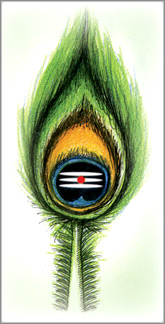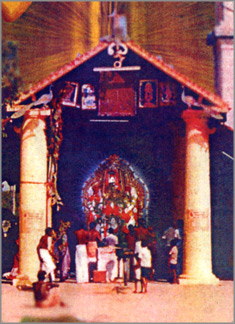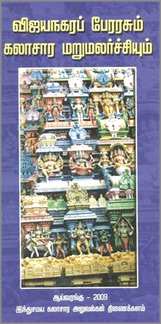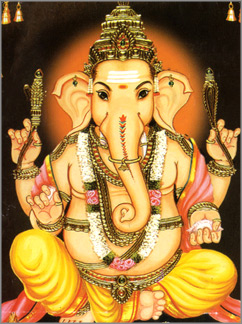|
HINDUISM
Annual homage to Lord Muruga
Chelvatamby Manikkavasagar
Selvasannithi temple which is dedicated to Lord Muruga is situated at
Thondamanam in Vadamarachchy in the Jaffna district. The Mahotsavam of
this temple commenced recently. The worship of Selvasannithi Murukan
temple is unique and regular poojas are conducted by priests covering
their mouths with clothes.
 |
|
God
Muruga's peacock feather |
It is very often said that “the creator of the universe Brahma
resides in the Naval of Lord Vishnu. Similarly in the hearts of men
reside the creative urge and faith. This is clearly evident from the
manner the people of Jaffna pray to God Muruga at Selvasannithi Temple
at Thondamanam.
Muruga means beauty and knowledge and he is often represented as a
type of perennial youth, sometimes as a Divine child and also as
Aammugan.
The great scholar and patriot Sir Ponnambalam Arunachalam described
that Muruga would thus appear to be a Deity who was rich with many
legends and traditions, many aspects of religion and modes of worship.
The origin of God Muruga and the story of his veneration are of great
interest. Muruga as a valorous youth is said to have performed several
brave deeds including the imprisonment of Brahma. God Muruga fought with
Asura leader Surapadman and defeated him.
Though Surapadman assumed several monstrous forms and shapes he
finally sought refuge in the form of a mango tree.
Surapadman was ultimately defeated, not slain, but was commanded to
serve God Muruga in the form of a peacock and was also given a place in
his banner as a rooster cock. Therafter the Devas were released and they
celebrated the victory.
Overcoming evil
Further, the leaf shaped Vel is God Muruga's weapon for overcoming
evil.
Vel in his hand also signifies that a man's knowledge should be sharp
like that of Vel and it should not only be sharp, it should also be
broad and deep.
This shaws that a man may be intellectually superior, but he should
be humble and simple in his life.
Lord Muruga is represented as having two consorts namely Valli and
Deivanai on either side of him. In fact “Valli” stands for
“Ichchasakthi”, the driving energy of the will, and “Deivanai” stands
for “Kriyasakthi”, the energy of the action. Both these energies are
essential for the embodied soul to live in this world. Without these
energies, the whole universe would be in a chaotic condition.
Furthermore, during the annual Temple festivals particularly at
Kataragama, Nallur and Selvasannithi, “Kavaddy-bearers” are a common
sight. The “Kavaddy” in its essence is a head-gear comprising two arches
ending in four legs. At the tip of each leg are fastened peacock
feathers to represent the Deity's “Vahana”, on a beam across the front
arch is suspended two brazen pots of milk which are offered to Skanda on
arrival at his shrine.
Rites
In fact, before a devotee dons the Kavaddy, he is purified for this
honour by a series of rites performed by the priest of his village
temple. He himself observes fasting and abstinence.
The ceremony accompanying the placing of the Kavaddy on his
shoulders, he undertakes his trudge to the venue of his vow, performing
a ritual dance to the accompaniment of musical instruments. The route
may be anything from a mile to ten miles or more in length.
 |
|
Selvasannithi temple |
On arrival at the Temple of Skanda, he walks round it once, beginning
from the right.
After this, the Kavaddy is removed from his head and the milk handed
over to the incumbent priests who perform the “Abishekam” ceremony.
During the festivals, we can see “Seddil” Kavaddy. In this the
devotee, in addition to carrying the traditional headgear, inflicts upon
himself considerable torture by setting himself pierced with as many as
1,008 spikes representing the weapons of Skanda.
Yet, another type of Kavaddy is what has been termed the “Anga Pura
Thadchana” Kavaddy in which the devotee finds his way to the temple,
rolling on the ground.
As he cannot dance in this case, the accompaniment is the chanting of
devotional songs.
Furthermore, unlike any other temples in the Jaffna peninsula, one
can see several Madams at “Selva Sannithi” temple where several
Sannyasis reside and meditate.
In this temple “Anna Danam” is served daily to the devotees.
According to Puranas, Lord Muruga is worshiped as the God of wisdom by
those who seek spiritual enlightenment.
The spiritual atmosphere at Selvasannithi temple heals physical and
mental ailments of his devotees.
During the Chariot or Ther festival the statue of Lord Muruga is
decorated and illuminated and paraded along the streets followed by
poojas, Bhajans, Devotional Songs and Archanai offered by devotees.
Religious works during the Vijaya Nagara period
K S Sivakumaran
The Vijaya Nagara Period in South Indian History is as fascinating as
the preceding periods. I found an article written by a great Tamil
scholar and writer from Thamilnadu the late Prof. M Varatharasan that
gives a lot of information on religious works belonging to the period.
This article in Tamil is included in a publication titled *Vijayanagara
Per Arasum
Kalasarara Maru Malarchiyum ( The Vijayanagara Empire and the
Cultural Rennaisance) published by the Hindu Cultural Department of
Lanka. Since the article is in Tamil, I wish to give the main points for
the benefit of readers in English.
 The Period concerned is between 1100 B.C. and 1700 B.C. The Vijaya
Nagara Regime originated in Andhra Pradesh and spread to the whole of
South India. In Mathurai with the backing of the rulers of Vijayanagar,
the Naayakkars established a reign. Since the Naayakar rulers patronized
religious arts and literature some great works were written during the
period. Commentaries on previous religious works, establishment of mutts
to protect religion, scholarly poets wrote on temple based eulogies,
little works came to be written in praise of chieftains, some works were
on themes of lust, and simple philosophical songs by Siddars, a kind of
foresighted sages works were also written. The Period concerned is between 1100 B.C. and 1700 B.C. The Vijaya
Nagara Regime originated in Andhra Pradesh and spread to the whole of
South India. In Mathurai with the backing of the rulers of Vijayanagar,
the Naayakkars established a reign. Since the Naayakar rulers patronized
religious arts and literature some great works were written during the
period. Commentaries on previous religious works, establishment of mutts
to protect religion, scholarly poets wrote on temple based eulogies,
little works came to be written in praise of chieftains, some works were
on themes of lust, and simple philosophical songs by Siddars, a kind of
foresighted sages works were also written.
Among the writers were Arunagiri Naathar, Villi Puthurar, Kaala
Megam, Kumara Kuruparar, and Sivaprakaasar. Most of the Siddars were
Saivaites, but generally they transcended all barriers of division.
They didn’t belief in rituals and the like. They only expressed what
they felt as experiences. They were not conformers and were rebellious
in their views. They used conversational language and folk poetry.
Some of the popular Siddars were: Paampaaddi, Ahapei, Alukani,
Kuthambai, and Kaduveli. Poiya Moliyaar wrote a compilation called
Thanjai Vaanan Kovai. It had 400 verses which give information on a
petty ruler.
There was revival and refurbishments of temples, big buildings, small
halls, religious works were broadly explained, commentaries on previous
great works were lucidly presented.
Nakkeerar wrote a critical commentary on Kalaviyal in the 8thcentury.
Ilampooranar wrote a complete commentary on Tholkaapiyam. Adiyaarku
Nallaar wrote a commentary on Silapadikaaram. One gets a lot of
information on ancient dramatic and music works.
Manak Kuviyar was among the 10 commentators on Thirkkural. Sanskrit
Puranas were translated into Tamil. Kachi Appar’s Kantha Puranam is
excellent. Sevvaich Chooduvaar translated the Sanskrit Mahabharatha in
5000 verses.
Kalidasa’s Raghuvamsam was translated by Arasakesari. Puhal Aenthi
sang the story of Nalan. A Paandyan descendant Athiveera Ramar wrote the
same in virutha metre.
Several other Sanskrit Puranas were translated into Tamil. The
article by Prof M Varatharasan continues. Readers who could read in
Tamil can benefit by reading these articles and the rest of the 12
studied essays found in this volume.
Students of Hindu Civilization and Medieval Tamil Literature are
bound to gather valuable information in this compendium.
[email protected]
Kali:
The Dark Mother
The love between the Divine Mother and her human children is a unique
relationship. Kali, the Dark Mother is one such deity with whom devotees
have a very loving and intimate bond, in spite of her fearful
appearance. In this relationship, the worshipper becomes a child and
Kali assumes the form of the ever-caring mother.
“O Mother, even a dullard becomes a poet who meditates upon thee
raimented with space, three-eyed, creatrix of the three worlds, whose
waist is beautiful with a girdle made of numbers of dead men's arms...”
(From a Karpuradistotra hymn, translated from Sanskrit by Sir John
Woodroffe)
Who is Kali?
Kali is the fearful and ferocious form of the mother goddess. She
assumed the form of a powerful goddess and became popular with the
composition of the Devi Mahatmya, a text of the 5th - 6th century AD.
Here she is depicted as having born from the brow of Goddess Durga
during one of her battles with the evil forces. As the legend goes, in
the battle, Kali was so much involved in the killing spree that she got
carried away and began destroying everything in sight. To stop her, Lord
Shiva threw himself under her feet. Shocked at this sight, Kali stuck
out her tongue in astonishment, and put an end to her homicidal rampage.
Hence the common image of Kali shows her in her mêlée mood, standing
with one foot on Shiva's chest, with her enormous tongue stuck out.
The fearful symmetry
Kali is represented with perhaps the fiercest features amongst all
the world's deities. She has four arms, with a sword in one hand and the
head of a demon in another. The other two hands bless her worshippers,
and say, “fear not”! She has two dead heads for her earrings, a string
of skulls as necklace, and a girdle made of human hands as her clothing.
Her tongue protrudes from her mouth, her eyes are red, and her face and
breasts are sullied with blood. She stands with one foot on the thigh,
and another on the chest of her husband, Shiva.
Awesome symbols!
Kali's fierce form is strewed with awesome symbols. Her black
complexion symbolizes her all-embracing and transcendental nature. Says
the Mahanirvana Tantra: “Just as all colors disappear in black, so all
names and forms disappear in her”. Her nudity is primeval, fundamental,
and transparent like Nature — the earth, sea, and sky. Kali is free from
the illusory covering, for she is beyond the all maya or “false
consciousness.” Kali's garland of fifty human heads that stands for the
fifty letters in the Sanskrit alphabet, symbolizes infinite knowledge.
Her girdle of severed human hands signifies work and liberation from
the cycle of karma. Her white teeth show her inner purity, and her red
lolling tongue indicates her omnivorous nature — “her indiscriminate
enjoyment of all the world's ‘flavors'.” Her sword is the destroyer of
false consciousness and the eight bonds that bind us.
Her three eyes represent past, present, and future, — the three modes
of time — an attribute that lies in the very name Kali (‘Kala’ in
Sanskrit means time). The eminent translator of Tantrik texts, Sir John
Woodroffe in Garland of Letters, writes, “Kali is so called because She
devours Kala (Time) and then resumes Her own dark formlessness.”
Kali's proximity to cremation grounds where the five elements or
“Pancha Mahabhuta” come together, and all worldly attachments are
absolved, again point to the cycle of birth and death. The reclined
Shiva lying prostrate under the feet of Kali suggests that without the
power of Kali (Shakti), Shiva is inert.
Kali's guises and names are diverse. Shyama, Adya Ma, Tara Ma and
Dakshina Kalika, Chamundi are popular forms. Then there is Bhadra Kali,
who is gentle, Shyamashana Kali, who lives only in the cremation ground,
and so on.
The most notable Kali temples are in Eastern India — Dakshineshwar
and Kalighat in Kolkata (Calcutta) and Kamakhya in Assam, a seat of
tantrik practices.
Ramakrishna Paramhamsa, Swami Vivekananda, Vamakhyapa, and Ramprasad
are some of the legendary devotees of Kali. One thing was common to
these saints — all of them loved the goddess as intimately as they loved
their own mother.
“My child, you need not know much in order to please Me.Only Love Me
dearly.Speak to me, as you would talk to your mother,if she had taken
you in her arms.”
- hinduism. about. Com
Paying tribute to God Ganesha
G Arulananthan
The Sri Sarwartha Siddhi Vinayagar Temple at Modera is dedicated to
Lord Ganesha. Its annual festival which commenced with the flag hoisting
ceremony on August 13 concluded with the chariot festival on August 21
and water-cutting ceremony on August 22.
Further, all the religious rituals during this festival were
performed by the chief priest of this temple “Sivagama Kiriya Youthi,”
“Sivagama Kiriya Rathnam”, “Siva Sri” Kumaraswamy Somasundara Kurukal
(JP) with the assistance of several other Hindu priests.
 |
|
God Ganesha |
Infact, the late S Sellamuttu who was the former mayor of Colombo, Mr
A Sinnathamby, Mr Ramana Sellamuttu, son of late S Sellamuttu and Dr A S
Kunasuigam were responsible for the reconstructions and restoration of
this temple which was in a state of dilapidated condition. In 1992, a
major repair was done to the roof of the main Vinayagas Temple. Even the
Vasantha Mandapam was re-done and in 1993 Mahakumbalisekham was
performed.
When Dr A S Kunasingham became the trusted of this temple, he took
all possible steps to give a new look to the temple. In 1994, the
construction of the Rajagopuram was completed and subsequently the
Mahakumbalisekham was held on 10 June 2005. The temple is now having a
dignified and magnified look, facing the sea. Indeed, Dr Kunasingham's
selfish divine service to this temple is immensely appreciated by the
people of all communities.
Indeed, the Hindu Temples are intended to instruct men in the art of
removing the veil of attachment that covers this hearts. Thus, the
renowned poet Thiyagarajah cried in the temple of Thiru Pathy, “remove
the veil, O! Remove the veil of attachment, the veil of pride and
hatred”. Further, the temples are meant for the testing of the values of
life and to awaken the divinity and humanity inducing men to believe
that the physical from in which he lives is itself the House of God.
Every Hindu temple has a sanctum dedicated to Lord Ganesha. Hindus
low this heads in reverence and make this first offering to Lord Gautha
in all ritualionic worship, be it pilgrimage, wedding, yagama as
housewarming. Lord Ganesha is the first Deity to be worshiped at the
beginning or any ceremony.
Different names
Vinayagar, Ganadathy, Vigneswara, and Pillaiyar are some of the
common appellations given to Lord Ganesha, the God with an elephant
head. The bulky body of Lord Ganesha stands for the cosmos in its
entirstes. The huge pot belly signified space certaining all things and
beings of the world. The trunk represents the sensitives reception of
stimuli and cognition. It also signifies the faculty of discrimination.
The broken tusk signifies that he has broken away from ignorance which
guides the path of God. The single tusk also denotes single mindeduces
in action. The other tusk indicates highest knowledges.
His broad ears signify that hears everything communicated to him.
They indicate omniscience. The three eyes of Lord Ganesha represent the
moon, the sun, and fire which in turn medicate the three phases of
creation, substance and destruction. The third eye is a symbol of
intuitive knowledge. He has four hands which signify supernatural
powers.
In one of his left hand he holds an “Ankusa” or the whip which
denotes the destructive phase of cosmos. The spear like weapon also
indicates that he used it to destroy ignorance in his devotees. The
third hand holds a dish of “Modhakam”. This signifies the fullness of
Brahman.
The fourth hand of Lord Ganesha represents Abhaya Lord Ganesha uses
his little mouse as his vehicle. This shows all beings high and low, big
and small are the vehicles of the divinity enshrined in the hearts of
the little mouse also stands for time. God is beyond time. The mouse is
the appropriate symbol of time.
Forms of worship
a common form of worship of Lord Ganesha is rapping at the forehead
with knuckles and pulling earlobes with cross hands. This act helps in
the purification of Naadis.
The smashing of coconut shows that the hard nut of ego should be
cracked and got rid of before God and subsequently prostrated for
complete surrounder. Further, the campliar that is in front of Lord
Ganesha signifies that we have to boon our illusion of Ego with the fire
of true knowledge and leave no so that we may merge with God.
The chariot or Ther symbolizes human body and the statue of Lord
Ganesha is the soul. In first of the chariot are the wooden horses
presenting in a galloping positive with the revive attached to this
months held in the hands of the image of Lord Ganesha. These horses
represent human while the symbolise the necessity of restraining and
guiding these passion by the soul. The Journey of the Chariot or Ther
through the streets is an emblem of the of life. This show that
throughout his life a man must central and guide his passions. These
positions are the motive power, the driving force or life, but
unstrained and not properly suited, they will wreck a main life. This is
the symbolic meaning of the chariot or Ther festival. |





